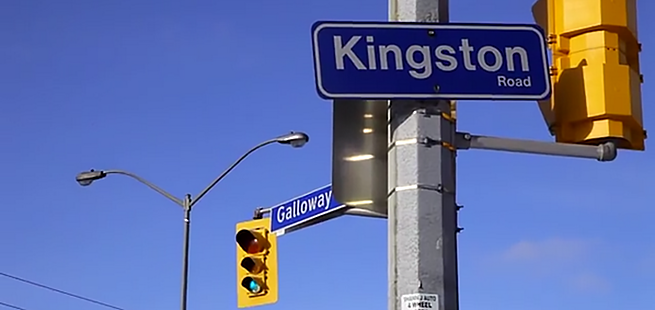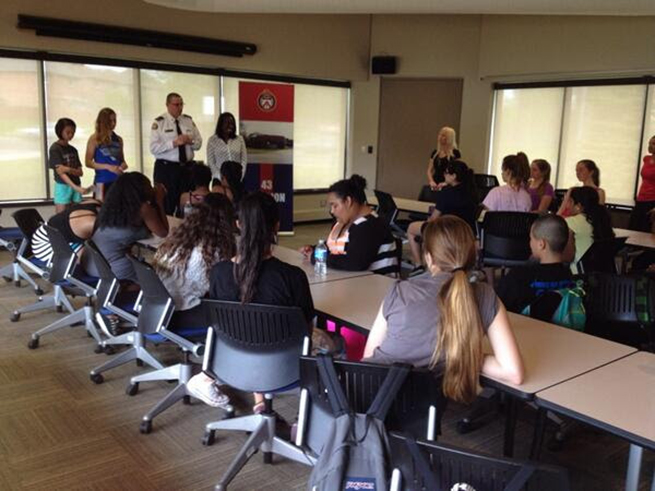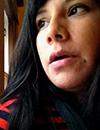
Photo: Satellite View of Kingston-Galloway/Orton Park in Scarborough, ON
Tammy Reid has lived in Scarborough for more than a decade and says the area around Kingston and Galloway streets is dangerous for Indigenous women and girls. Reid—not her real name—says she knows one Indigenous woman who was beaten there with a golf club. Reid, a mother of two, is concerned about the high rates of domestic violence taking place toward Indigenous women and girls in the Scarborough area. Reid says much of this violence goes unreported.
Reid herself came from a family where violence and sexual abuse was all too common, just like the violence she sees in Scarborough today. But while too many Indigenous women are in unhealthy and violent relationships, a growing number face a new horror.
Young Indigenous girls are being trafficked—sold for sex—in the Kingston-Galloway area, many times shuffled from one hotel to another. “I know these young girls are coming to Toronto and they’re culture shocked when coming to Toronto and they get preyed upon,” says Reid. “These young girls can easily get picked up to be forced into prostitute or to do petty theft.”

Recently, the Alliance Against Modern Slavery released a report on human trafficking in Ontario. Of the 551 cases reported, close to 63 per cent of victims trafficked in, throughout, or from the province were Canadian citizens, 90 per cent were female and 63 per cent were between the ages of 15-24.
The GTA was regarded as the most common destination site for human trafficking and a hub for human trafficking routes. Michele Anderson is a human trafficking specialist at Covenant House in Toronto. She says some of these girls are coming from the north. It’s a network, she explains. “There are traffickers and pimps who will then move the girls to Montreal,” says Anderson. “They move them across different jurisdictions to avoid detection.”
Anderson’s been working with exploited women and girls for well over two decades. Anderson says pimps will begin to shower these young, vulnerable girls with gifts and affection. Soon, alcohol and drugs will be introduced. “The girls believe this man, this pimp, is her boyfriend when in fact he’s grooming her to exploit her,” says Anderson. “He will have her start to turn tricks and take all the money from her.” Next, the girl is trapped, regularly threatened, and moved from one motel room to another. Often her identification is taken. “They’ll keep them trapped,” she says. “It is extremely difficult for them to break free.”

Massage parlors are another place where these girls are being trafficked. Carly Kalish, a therapist with East Metro Youth Services located in Scarborough says Indigenous women and girls are easy targets for traffickers. Young girls are forced into sex work in hotels while older Indigenous women are more likely to do street level work in downtown Toronto, she says. “Scarborough is one of the stops on the circuit for trafficking,” says Kalish. “It’s a terrible thing to say but [from the pimps’ perspective] it’s a good place to be trafficked into.” Kalish says Scarborough is not only large and spread out but also suffering from a lack of transportation, infrastructure, and services for Indigenous women and girls.

Sergeant David Correa with the Toronto Police Sex Crimes Unit could only say their investigations do not consider the ancestry of a victim. Their unit may only suggest culturally based services to an Indigenous woman. Liberal MPP Mitzie Hunter (Scarborough-Guildwood) is aware of the growing issue of violence against Indigenous women and girls in her riding. Recently she raised this concern in the legislative assembly. “We know that Aboriginal women experience spousal violence 3 to 5 times higher than non-Aboriginal women,” says MPP Hunter. “The entire community needs to do more.”

Hunter says she joins many national Indigenous organizations in calling for a public inquiry into the shockingly high numbers of missing and murdered Indigenous women and girls. A number the RCMP recently stated was nearly 2,000 in the past 30 years. East Metro Youth Services is an agency that’s hoping to lower those numbers. It plans to reach out even more to the Indigenous community, in particular to women and girls. Tracking cases will also be on their to-do list, says Kalish.


Tammy Reid is another person from the area who would like to see more services for Indigenous youth and women. “There are many suffering from mental health issues, but there’s nobody to help them. Something drastic has to happen in order for the mental health act to kick in.” Reid would like to someday work with young Indigenous girls in the area, offering them the kind of future she wants for herself and her children.










